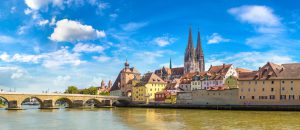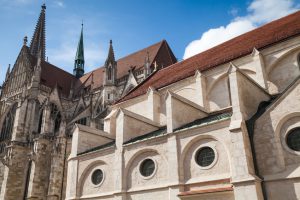Regensburg, Germany with its medieval charm
By Tracy A. Burns
 A UNESCO World Heritage site since 2006, Regensburg holds the distinction of being the only preserved medieval town in Germany. To be sure, the city is architecturally fascinating with a Gothic cathedral and a Rococo palace as two of the many highlights. Large, pastel-colored patrician houses with towers and inner courtyards are sprinkled throughout the Bavarian town that was once frequented by emperors, dukes, and princes.
A UNESCO World Heritage site since 2006, Regensburg holds the distinction of being the only preserved medieval town in Germany. To be sure, the city is architecturally fascinating with a Gothic cathedral and a Rococo palace as two of the many highlights. Large, pastel-colored patrician houses with towers and inner courtyards are sprinkled throughout the Bavarian town that was once frequented by emperors, dukes, and princes.
History of Regensburg
Regensburg’s history can be traced back to a Roman settlement founded in 179 AD. Remnants of a Roman wall and a Roman gate, the Porta Praetoria, are reminders of that era, which lasted for almost 300 years. By the year 1200, about 20,000 inhabitants called Regensburg home; it was one of the biggest cities in Europe. Regensburg’s location on the Danube River made it a significant trade center. In 1245 Regensburg was made a free imperial city. After the Turks conquered Constantinople, Regensburg was no longer a major trade hub but rather a provincial town facing serious financial problems. Anti-Semitism abounded, and Jews were expelled from Regensburg in 1519. From 1663 to 1806 the Imperial Diet, the first German Parliament held its political meetings at the Old Town Hall, and Regensburg found itself in the limelight again, with princes and electors staying in the town.
The end of the Imperial Diets through World War II
However, things changed during Napoleon’s tenure. There were no more Imperial Diets, and the town lost its independence in 1806. Soon thereafter, Regensburg was made part of the Kingdom of Bavaria. During World War II the town was spared extensive damage, with only 13 percent of the town destroyed, allowing it to remain medieval in character. For four years after the war, the largest displaced persons’ camp in Germany was located there.
St. Peter’s Cathedral: the exterior
 After the original town cathedral was destroyed by fire in 1273, St. Peter’s Cathedral was erected, but it would take about 600 more years to complete it. The architectural gem shows off a distinctly Gothic style influenced by France. The sculptural ornamentation on the exterior is considered to be some of the most remarkable decorations from medieval times.
After the original town cathedral was destroyed by fire in 1273, St. Peter’s Cathedral was erected, but it would take about 600 more years to complete it. The architectural gem shows off a distinctly Gothic style influenced by France. The sculptural ornamentation on the exterior is considered to be some of the most remarkable decorations from medieval times.
The interior
Inside, the cathedral boasts medieval stained glass windows, created from 1300 to 1370. Sculptural decoration includes 14th-century figures of St. Martin and St. George on horseback. One unique feature of the interior is The Devil and His Grandmother, grotesque figures with human heads near the main entrance. A highlight of the cathedral is the Smiling or Laughing Angel, one of the sculptures from an Annunciation scene.
The Stone Bridge
Make sure to walk across the 30-meter-long Stone Bridge for splendid views of the town. It hails from the 12th century and features 15 arches. Many centuries ago, Crusaders marched over this bridge during their journey to the Holy Land. A museum explaining the rich history of the bridge is located nearby.
The Alte Kapelle
The exterior of the Collegiate Church of Our Lady of the Alte Kapelle features medieval sculptures around the main portal. Yet the interior is entirely different, seeping with Baroque and Rococo adornment hailing from the 18th century. The central painting shows the Pope presenting Holy Roman Emperor Henry (Heinrich) II a picture of the Virgin Mary. Stucco’s work and vibrant frescoes astound, though they can only be viewed through an iron grille.
The Church of St. James
While there are numerous churches to explore in Regensburg, one of the most stunning is the Church of St. James. Erected by Scottish monks in 1150, its Romanesque entrance portal is decorated with sculptural figures and grotesque symbols.
Emmeram Abbey
This former monastery was independent of the bishopric from 975 to 1803. During the early 19th century, though, it was secularized. That’s when the King of Bavaria gave the abbey to the Thun und Taxis family. It was compensation for the nationalization of the postal services that the prominent clan had controlled since the 15th century. Named after a bishop who had lived in Regensburg during the eighth century, the monastery dazzles with its Baroque frescoes that narrate Emmeram’s life story, horrible death – he was tortured and cut into pieces – and sainthood. The altars dotting the spaces are breathtaking, too.
The Thun und Taxis Palace
The residence of the noble clan that created the first postal system at the end of the 15th century is the largest residential palace in Germany, with more than 500 rooms. The lavish palace includes 14 marble staircases. Check out the grotesque creatures depicted on the ceiling of the Conservatory and the Brussels tapestries in the Large Dining Room. The Ballroom flaunts Rococo and Neo-Rococo styles. The Green Salon features a bed adorned with four swan figures on its legs and a curtain depicting golden bees. In the chapel, alloyed coats-of-arms adorn the windows. The cloister area of the palace is astounding, too, with statues from as far back as 1200 and Romanesque arches. A museum also is located on the premises. It features stunning artifacts, such as a ceremonial chair, Biedermeier furniture, and a rare complete porcelain service set from the 1700s.
The Old Town Hall
The central part of this building dates back to the 13th century, but other sections are even older. Take a look at the Gothic windows on the first floor. Don’t miss out on the tour of the Old Town Hall, which shows off posh rooms where the Imperial Diets had taken place for almost 150 years. The torture chambers below include a three-meter deep dungeon in which a Jewish headstone was used as a toilet seat and various torture instruments.
Neupfarrplatz
Homes of 400 Jews had been located at Neupfarrplatz before they were expelled during the 16th century. While fashionable shops now call the square home, a stirring relief near the center of the square portrays the floor plan of a Jewish synagogue that once stood on that site. In 1990 archeological excavations revealed the cellars of these houses. Tours called document Neupfarrplatz allow visitors to explore this underground area, but they are only given in German.
Museums and more
Regensburg is also known for its museums. The Historical Museum has an impressive collection of Roman and medieval artifacts, for instance. The East German Gallery presents contemporary art by artists who hail from countries that were formerly part of the East Bloc. The beautiful town park is nearby. Regensburg is famous for its romantic Christmas markets, too. Tea lovers will want to visit the many tea shops that dot the center of town.
An architectural wonder
Regensburg is a town for walking. Take a stroll through the city’s heart to appreciate the medieval appearance and feel the exciting history, from Roman times to the present.




